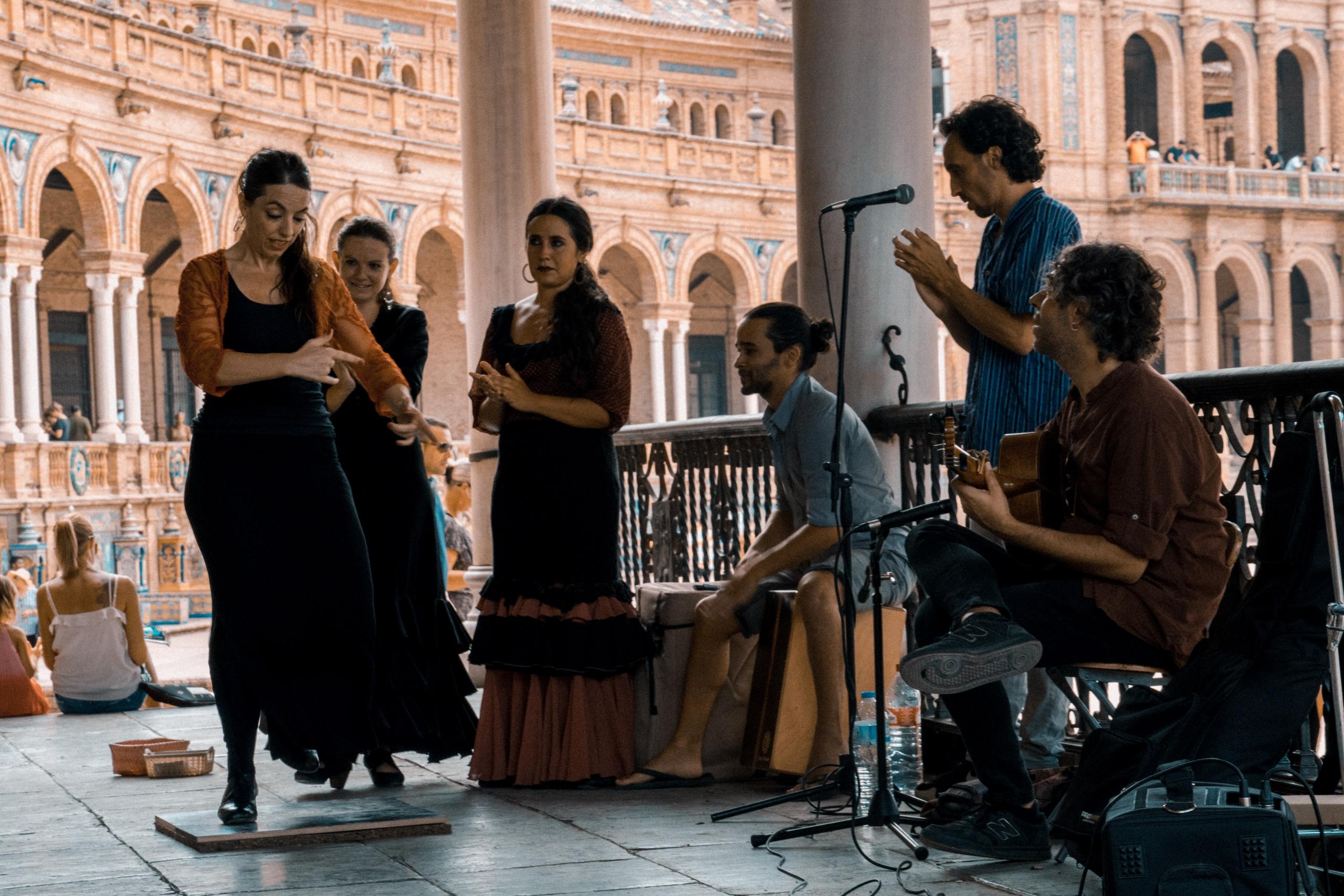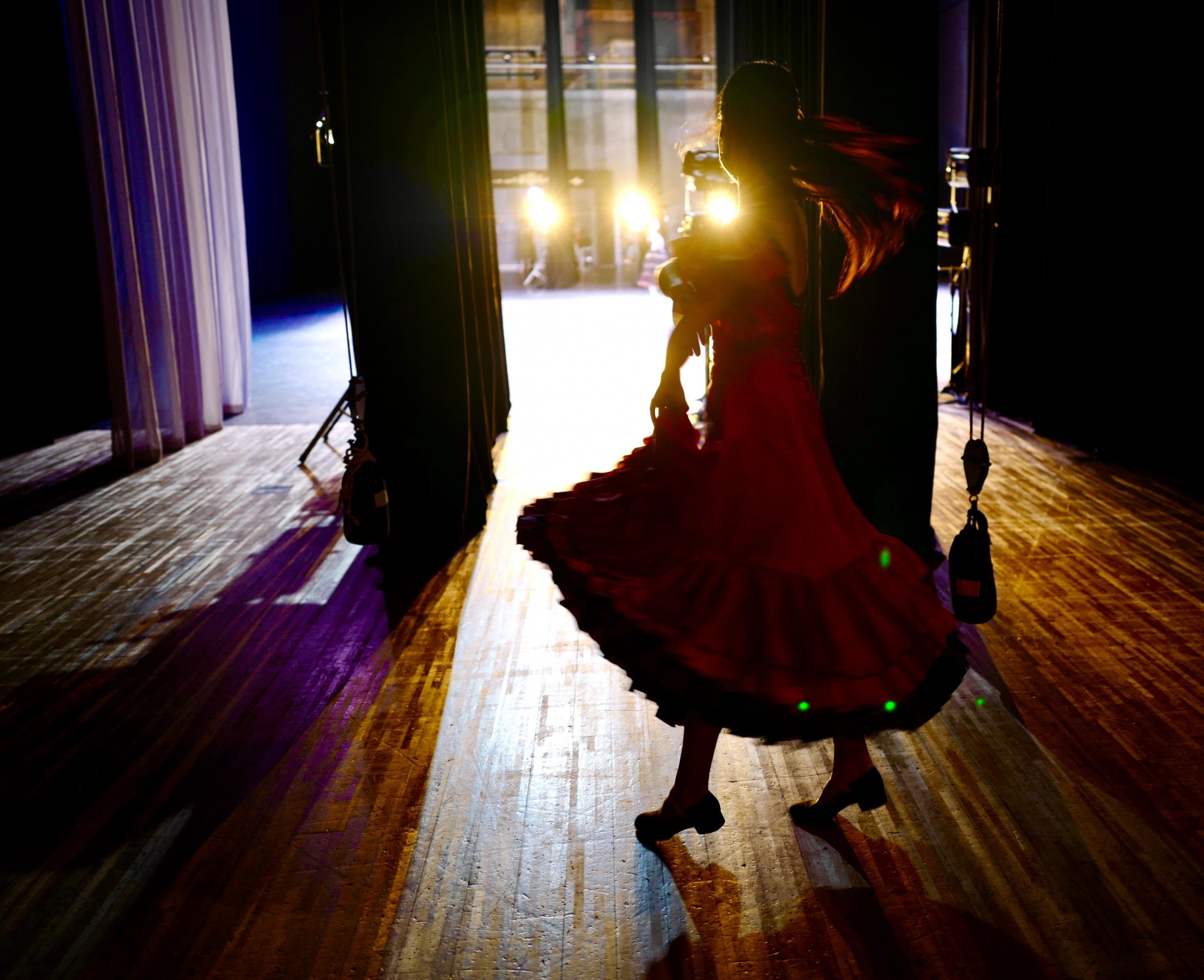Flamenco is a type of Spanish traditional dance. It is originally from the southern region of the country, but with time it has evolved to different songs, styles, Palos, and movements.
Continue reading to learn about the history of flamenco, the traje del flamenco (the dress), the origins of the music, the origins of the dance, and more.
Learn about the history of flamenco dance.


Flamenco through the years
Flamenco has its origins associated with the Andalusian Roma (gypsies) of southern Spain. The origin of flamenco is a little unknown, however, it is believed that it was brought to Spain by the gypsies who migrated from India between the 9th and 14th centuries.
The Andalusian Roma or gypsies brought with them a bunch of instruments and music that they shared with the existing cultures in the Spanish grownds.
The mix of rich cultures between the Andalusian Roma, the Hispanic Jews, and the Western Arabs, resulted in the rare, beautiful, and unique art form known as flamenco.
Even though flamenco dates back to the 9th century, its golden era was between 1780 and 1845. Back then, singing and songs were the main aspects of the art and the musical part and dancing were just a mere accompaniment.
Before 1842 flamenco was an outdoor activity, something that you could enjoy with your family during a nice day out. It eventually evolved with the first café cante, an establishment founded in Seville.
These cafes (that soon spread from Seville to Granada and Cordoba) gave protagonism to dancers and musicians. During this period, the singers started to take a secondary role in flamenco and the true artists were the people who danced.
Find dance classes near me here on Superprof and continue reading if you wish to learn about the top flamenco artists.

The cafes also gave flamenco a commercial appeal. This was great for the artists because they could make a living from their art, however, some experts considered that the commercial interests in the cafes lowered the quality of the original and authentic flamenco forms.
Many experts worked and currently work to restore and bring back flamenco to its original form. In 1922 some intellectuals created the first flamenco competition where they invited dancers to perform original dances or Primitive Andalusian Cante.
This timely attempt to prevent the further debasement of authentic folk art effectively promoted flamenco to a sophisticated urban public and helped to further the thoughtful development of the art within a modern context.
Find dance lessons here.
Traje de Flamenca or flamenco dress
The traje del Flamenco, flamenco outfit, or gypsy outfit, is a dress commonly worn by women at festivals in Andalusia, Spain. There are two types of dresses, the one worn by dancers who will perform at the Andalusia festival, and the one used casually as a day dress, also very popularly used at Andalusia festivals.
If you haven't ever seen a flamenco dress, it is tight in the upper part of the body, and from the waist down the skirt part of the dress has multiple layers of ruffles. Some dresses also have ruffles on the sleeves, but others don't have sleeves or have short ones.
They are typically red and with some patterns or designs on the edges. They can also be white or black and the most popular pattern in flamenco dresses is the polka dots.
The dress is typically covered by a pink or white shawl that you can wear over the shoulders. Finally, someone dancing usually wears their hair on a tight high bun and decorates their hair with flowers and a decorative scrunchy.
The classical outfit originally belonged to the gypsies and it is now known as a traditional suit for artists and dancers from Andalusia. The origin of the dress is not that long ago. It originated in the 19th and 20th centuries.
Women merchants would wear gowns trimmed with ruffles to the fairs where they used to work. With time, other women started copying these dresses and wearing them in public. Eventually, the dress evolved into what we all know today.
In 1929 in the Seville Exposition, this dress gained the status of the official outfit of the event.

History of the music/ cante
Flamenco's essence relies on the cante which means song. Music is the essence of flamenco because it was the first thing to be born, and from it, flamenco was developed.
There are many variants of cantes or Palos (forms), each expressing a unique emotion and its rhythm. Flamenco songs are divided into three categories.
- Cante jondo (profound song) - it is known as the original song and it consists of an elaborate 12-beat rhythm. Cante jondo is known as profound because it deals with profound emotion and it usually addresses topics such as despair, religious doubt, anguish, and death.
- Cante intermedio (intermediate song) - it is a mix or hybrid of different Spanish music sounds. It is characterized as being less profound than jondo but still very moving.
- Cante chico (light song) - it has a complex rhythm as the other two forms but it has less emotional investment as the jondo and intermedio. It usually deals with topics like love, humor, and lighter topics.
The way to differentiate these three song styles is by paying attention to the topics they deal with, their rhythms, and guitar chord structures. However, they can be similar and share guitar chords and rhythms with each other, what they don't share are the themes and content.
Flamenco music has many influences too. There's influence from Spanish folk song and dance, Arab music, and even in the later genres, there's a hint of Latin American influence with rumbas gitanas, and colombianas.
If you go to Spain, you'll see that the flamenco culture exists mainly in the southern region of the country, in cities like Granada, Seville, and Malaga.
Granada is a particularly famous spot in the country because it was one of the many popular film locations for the hit show Game of Thrones. However, people who visit Granada find that there is much more to discover in the city aside from the breathtaking scenery. Seville is also very popular amongst tourists because of its beautiful and colorful scenery.
The origin of flamenco dancing
After the music came the dance.

During the 19th century, flamenco started to not only be about music but it started to be accompanied by a Palo Seco (dry stick) and a dancer.
The Palo Seco or dry stick was a wooden stick used to keep time by having someone beating it on the floor. And the dancer would perform a series of dance steps that were both choreographed and improvised. Ever since the 19th century, dancing has been a key and dominant element of flamenco.
Flamenco is now a synchronized art between the dancers and singers. Both artists tell daily life stories and reflect on experiences related to their history. The artist dancing is the protagonist of the singer’s narrative and its interpreter.
Flamenco dance is characterized by its expressive use of arms and rhythmic tapping of the feet. The entire ensemble consists of movement of the arms (braceo), movement of the upper torso, footwork (zapateado), heelwork (taconeo), and hand and finger movement (florea).
These movements are also divided between males and females. Male dancers usually perform sophisticated and complex footwork, whereas female dancers emphasize their hands and upper torso. The guitarist is responsible for keeping the rhythm which is essential for the dancer’s rhythm.
A dancer also performs something called the duende which is an intensely focused, almost like a trance state, known as Los Sonidos Negros (the dark sounds) which is described as an invitation of the dancer's body. This state is very popular amongst the audience and they always accompany it with rhythmic hand clapping.
A gypsy flamenco artist perceives the cante jondo as a form of prayer and during duende, they believe that the performer is communicating with both the audience and God.
The important thing to understand about flamenco is its spirituality and expression of the self through dance and music. There are many different forms, characteristics, styles, rhythms, and movements that together make up this beautiful yet intricate form of art.
Unleash your inner rhythm and spice up your dance journey! Join our invigorating hip hop dance class for adults, a perfect complement to your regular flamenco classes. Infuse your movement with the dynamic beats of hip-hop while maintaining the passionate flair of flamenco, creating a unique and eclectic dance experience that harmonizes tradition with contemporary style.















